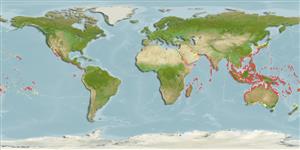|
Not assigned |
Cerithiidae
Environment: milieu / climate zone / depth range / distribution range
Ecologia
; intervalo de profundidade 0 - 23 m (Ref. 349). Tropical
Indo-Pacific.
Length at first maturity / Tamanho / Peso / Idade
Maturity: Lm ? range ? - ? cm Max length : 7.0 cm SHL macho/indeterminado; (Ref. 349); common length : 5.0 cm SHL macho/indeterminado; (Ref. 349)
Collected for food and its shell where abundant (Ref. 349). Common, and frequently heavily preyed upon by other gastropods such as ranellids, muricids and naticids, or by crabs (Ref. 349). Members of the family Cerithiidae are herbivore-deposit feeders (Ref. 1385).
Life cycle and mating behavior
Maturidade | Reprodução | Desova | Ovos | Fecundidade | Larvas
Members of the order Neotaenioglossa are mostly gonochoric and broadcast spawners. Life cycle: Embryos develop into planktonic trocophore larvae and later into juvenile veligers before becoming fully grown adults.
Poutiers, J.M. 1998. (Ref. 349)
Categoria na Lista Vermelha da IUCN (Ref. 130435)
Categoria CITES (Ref. 108899)
Not Evaluated
Not Evaluated
Ameaça para o homem
Harmless
Utilização humana
| FishSource |
Ferramentas
Mais informação
Idade/TamanhoCrescimentoComprimento-pesoComprimento-comprimentoMorfologiaLarvasAbundância
Fontes da internet
Estimates based on models
Preferred temperature
(Ref.
115969): 23.9 - 29.3, mean 28.3 (based on 3808 cells).
Vulnerabilidade
Low vulnerability (10 of 100).
Categoria de preço
Unknown.
